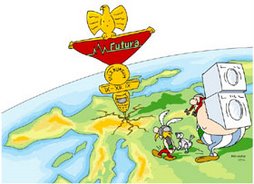The idea and the concept of “globalization” is speciously simple. The free market must be allowed to operate without interference. Governments must remove all barriers and obstacles that prevent the full and free operation and movement of goods and services, capital, firms and financial institutions across borders.
Globalization is the gradual deconception of the weakening of state powers. It can also show us how an individual and simple life can be transformed by global forces and powers, and one can expand one’s connections around the whole world.Globalization shows that individual lives become affected not just by their local communities, but by economic, political, and cultural processes or forces that operate worldwide. Indicators of globalization include when a country or leader with problems experiences interference from outside, for example the international prosecution of Slobodan Milosevic for war crimes.
There is globalization from above, and from below. Globalization from above brings about prevalent elites, and economic and cultural hegemony. Multinational corporations creating bourgeoisie elites who bring cars, music, and a different way of life into developing countries falls under the category of globalization from above. The emergence of women’s rights in developing nations and organizations like grassroots Africa Watch, Amnesty International, and People Against Torture are all examples of globalization from below.
Countries must face selection and make choices
The lesson of several experience is that a country must carefully choose a combination of policies that best enables it to take the opportunity, while avoiding the pitfalls. That is a tast easier said that really done. A place or a country that is poor in all cases or developing may find that it is not wise to jump blindly into a complete integration with the world economy, fpr this may open it up to many risks that can damage its local economy. It is wiser to engage in a selecitive and strategic integration with the world market. In this approach, the country itself chooses: 1. the way and degree it wants to open up, 2. the timing and sequence of opening up, 3. the form of competition and cooperation between its local firms and foreign firms, 4. the particular sectors it wants to liberalize and those sectors that still need some protection, for the good of the country. Nevertheless the countries must face all threats and take care of themselves not to fall down in pits.









No hay comentarios:
Publicar un comentario